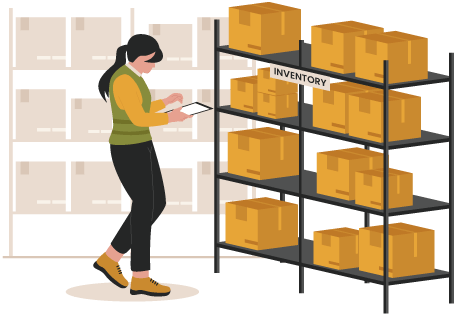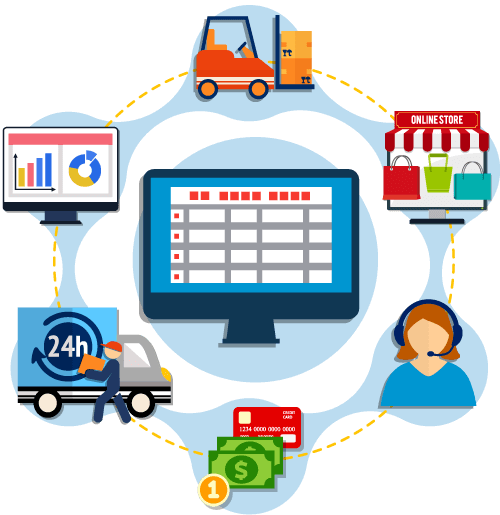What is the goal of a good inventory system?
Built For


What is the goal of a good inventory system?
Imagine walking into your favorite coffee shop, craving that perfect cup of morning brew, only to find they’ve run out of your preferred blend. Frustrating, right? This is a classic example of what businesses aim to avoid through effective inventory management.
At its core, an inventory system is about more than just counting products; it’s about ensuring the right products are in the right place at the right time. In today’s fast-paced market, where consumer satisfaction can make or break a business, the role of a good inventory system becomes undeniable. Whether it’s a small niche supplier or a large multinational corporation, managing inventory efficiently is crucial for meeting customer demands and maintaining seamless operations.
So, what exactly should a good inventory system achieve? Let’s dive in and find out how these systems are not just about keeping the shelves stocked but are integral to the strategic success of any business.
Inventory Systems and the Importance of Management Software
Inventory systems are fundamental tools that help businesses track and manage their stock levels, orders, sales, and deliveries. While the traditional methods ranged from simple manual tallying to using spreadsheets, today’s technological advancements have significantly changed how companies handle inventory.
The Shift to Digital: Why Inventory Management Software?

- Automation: One of the most compelling capabilities of inventory software is its ability to automate product tracking. This means activities like ordering, storing, and selling inventory are managed automatically, minimizing human error and increasing efficiency.
- Real-Time Data access allows businesses to see exactly what’s in stock at any moment, helping to prevent situations where items are overstocked or, conversely, out of stock. This capability is crucial for maintaining the balance between meeting customer demand and minimizing carrying costs.
- Analytical Insights: Beyond mere tracking, modern inventory systems are equipped with analytical tools that provide deep insights into sales trends, seasonal demands, and customer preferences. These analytics help businesses forecast future needs more accurately, ensuring they make smarter purchasing decisions.
- Scalability and Adaptability: As businesses grow, their inventory needs become more complex. Inventory management software is designed to be scalable, meaning it can expand and adapt to a growing business’s needs without a complete system overhaul. This adaptability makes it a long-term solution that supports business expansion and complexity.
Primary Goals of a Good Inventory System

A well-functioning inventory system is crucial for any business looking to streamline operations and enhance efficiency. Here are the key goals such a system aims to achieve:
Accuracy
- Record-Keeping Precision: One of the main objectives of an inventory system is to maintain accurate and up-to-date records of stock levels, orders, and deliveries. This accuracy is vital for ensuring the business can meet demand without overstocking, which ties up capital unnecessarily, or understocking, which leads to shortages and potential sales losses.
- Error Reduction: Good inventory systems reduce the likelihood of human error by automating data entry and tracking, which can lead to mismanagement of inventory and financial discrepancies.
Efficiency
- Inventory Handling Optimization: Efficiency in an inventory system means minimizing the time and effort required to manage stock levels. This includes automating order placements, optimizing stock retrieval, and streamlining restocking.
- Cost Reduction: Efficient inventory management helps reduce costs associated with holding too much inventory, including storage, insurance, and spoilage, thereby improving overall financial performance.
Visibility
- Real-Time Tracking: Visibility into inventory levels enables swift responses to changes in demand or supply chain disruptions. Real-time access from anywhere, at any time, provides critical data at a glance.
- Forecasting and Planning: With better visibility, businesses more accurately forecast future inventory needs based on historical sales data, current market trends, and seasonal fluctuations. This planning capability helps ensure they are always prepared to meet customer demands.
Benefits of Achieving These Goals
Implementing a good inventory system that achieves accuracy, efficiency, and visibility can transform a business’s operations. Here are the key benefits:
Cost Savings
- Reduced Inventory Costs: Accurate inventory systems prevent overstocking and understocking, which can be costly. By maintaining optimal inventory levels, businesses reduce storage costs, minimize spoilage for perishable goods, and decrease insurance costs related to holding excess inventory.
- Lower Labor Costs: Efficiency in inventory management means less time spent on manual tasks such as counting stock and processing orders, which can reduce labor expense and redirect resources to more value-added activities.
Improved Sales
- Stockout and Overstock Avoidance: By maintaining accurate inventory records and having real-time visibility, businesses avoid the pitfalls of stockouts that lead to lost sales and customer dissatisfaction, as well as overstocks that tie up capital in unsold goods.
- Enhanced Customer Satisfaction: A reliable inventory system ensures that products are available when customers need them, enhancing customer satisfaction and loyalty.
Better Decision Making
- Data-Driven Insights: With accurate data, businesses make more informed decisions about what to stock, how much to order, and when to run promotions. This strategic decision-making based on real-time data helps align inventory with market demands.
- Forecasting and Trend Analysis: Good inventory systems provide tools for forecasting and analyzing trends, allowing businesses to anticipate customer preference changes and adjust their strategies accordingly.
Increased Flexibility and Responsiveness
With a robust inventory system, businesses can quickly adapt to market changes or supply chain disruptions. This flexibility is crucial in maintaining operational continuity and meeting customer demands even under challenging circumstances.
By focusing on achieving these primary goals, businesses not only streamline their inventory processes but also build a foundation for sustained success and growth. Each benefit interlinks, creating a ripple effect that enhances overall business performance.
Key Features of a Good Great Inventory System, like Acctivate

A great inventory system includes critical features that streamline operations and enhance business efficiency. Here are the key features that define a top-tier inventory system:
Inventory Control
- Stock Level Optimization: Inventory systems dynamically suggest stock levels adjustments based on real-time sales data and forecasts to balance supply and demand. This includes setting minimum and maximum levels to ensure operational flexibility while minimizing carrying costs.
- Return Management: Efficiently handling of returns and exchanges with RMA features allows for quick reintegration of products into inventory or proper disposal, if necessary. These features help maintain accurate stock counts and reduce losses from returned goods.
- Serial and Lot Tracking allows businesses to track items individually by serial numbers or as groups with lot numbers, which is crucial for quality control, recall capabilities, and expiration management.
Warehouse Management
- Optimized Layout and Picking Routes: Advanced systems help design warehouse layouts that reduce travel time and streamline the picking and packing processes, significantly speeding up order fulfillment.
- Barcode Scanning: Incorporating barcode scanning technology improves accuracy in inventory counts and operations, reducing errors and speeding up the inventory management process.
Advanced Purchasing
- Supplier Management: Great inventory systems include tools for managing supplier relationships, tracking supplier performance, and negotiating better terms.
- Reorder Alerts are triggered based on predefined stock level preferences, ensuring that inventory is replenished precisely when needed.
- Purchase Order Automation: Purchase order creation is completed quickly and easily based on inventory needs, historical sales data, and future forecasts, making purchasing more efficient.
Centralized Order Management and Fulfillment
- Multi-Channel Integration: Centralized inventory management systems consolidate sales from all channels (website, online marketplaces, EDI, direct sales, mail order), managing all orders in a unified interface, simplifying fulfillment and customer service.
- Drop-Shipping Support: Support for drop-shipping logistics allows businesses to fulfill orders directly from suppliers to customers, reducing inventory holding costs.
Business Insight
- Reporting and Dashboards: Comprehensive dashboards and reporting tools provide insights into inventory health, sales trends, and operational efficiency, enabling strategic decision-making.
- Performance Metrics: Track key performance indicators (KPIs) such as stock turnover rates, order fulfillment times, and inventory accuracy.
QuickBooks Integration
Seamless integration with QuickBooks ensures all inventory activities are reflected in financial records in real time.
Great Inventory System FAQs
Can small businesses benefit from inventory systems, or are they just for large enterprises?
Small businesses can significantly benefit from inventory systems. The systems can be scaled to fit the size and needs of the business, helping even small operations streamline inventory control, improve accuracy, and enhance customer satisfaction without the complexity or cost associated with larger systems.
Does inventory software integrate with QuickBooks?
Inventory software integrates with QuickBooks, allowing data to flow seamlessly between systems. This ensures inventory levels, financial data, and customer interactions are always updated and consistent, enhancing decision-making and operational efficiency.
What should I look for when choosing an inventory management system for my business?
When choosing an inventory management system, look for features matching your business needs, such as real-time tracking, demand forecasting, and easy integration with QuickBooks. Additionally, consider the system’s scalability, user-friendliness, and the quality of customer support.
Call us at 817-870-1311



